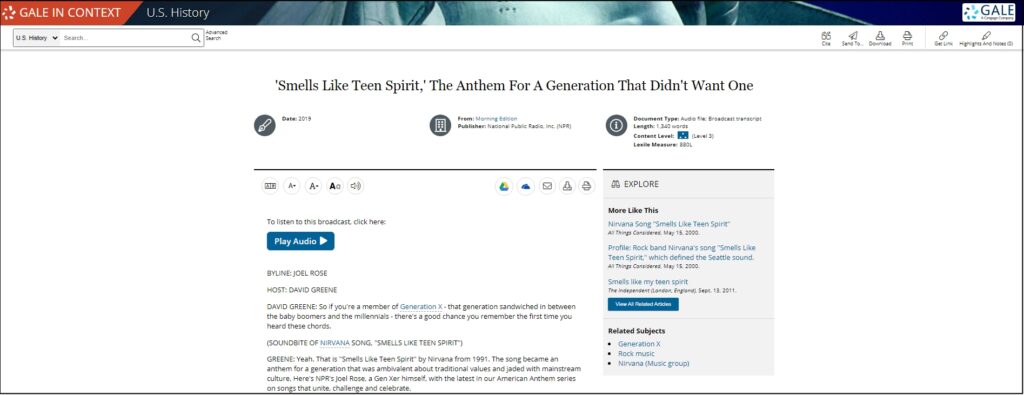| By J. Robert Parks |
There are certain public figures who are seen as embodying their generation, and if they die before they reach old age, especially in tragic ways, their deaths can be seen as the end of an era. So it was with President John F. Kennedy in 1963, with John Lennon in 1980, and with Kurt Cobain in 1994, whose death by suicide occurred thirty years ago this week, on April 5, 1994. Educators and librarians wanting to help their students understand music history or 1990s culture, or maybe just looking to take a trip down memory lane themselves, will find plenty of resources in Gale In Context: U.S. History.
Kurt Cobain was the lead singer and primary songwriter for the rock band Nirvana, and it’s difficult to overstate the impact the band had when they released their album Nevermind in 1991. It would be both a cliché and incorrect to state that the album’s first single, “Smells Like Teen Spirit,” sounded unlike anything that had come before. Many listeners of the time noted that the song had a striking similarity to “More Than a Feeling,” the monster hit by the band Boston from the 1970s. Nonetheless, Nirvana’s song sounded new and fresh, and as NPR’s Joel Rose noted in 2019, it became “the anthem for a generation that didn’t want one.”

Rock music in the 1980s was dominated by new wave and heavy metal, two genres where style was integral to the music. Nirvana and the grunge bands that followed them definitely had a look, but it was a defiant response to the glam of the decade before. Grunge was designed to look like you did not care, that you had woken up in the morning and put on the flannel shirt that you left on your floor the night before. The music had a similar quality, taking the approach (and some of the politics) of the 1970s punk rock movement and updating it for the 1990s. Although Cobain and his bandmates in Nirvana were meticulous about their music, their persona and even the music itself made it sound like they had just ripped their three chords and the truth and put it on vinyl. For the Gen Xers who flocked to the grunge movement, that apparent authenticity was refreshing.
Cobain wore that authenticity more manifestly than most. His tortured-soul persona was no act. In a more modern time, he might have been diagnosed as bipolar. He was addicted to heroin, and his marriage to the singer Courtney Love was fraught. The month before he committed suicide, Cobain suffered an accidental drug overdose. On April 5, 1994, alone in his house in Seattle, he killed himself with a shotgun. It was a particularly defiant way to die.
It is interesting to ponder how much of an impact Cobain and his music have been able to sustain into the present day. One Nirvana bandmate, drummer Dave Grohl, went on to form the band Foo Fighters, which continues to make music and sell out arenas and stadiums. Foo Fighters is an influential band with a large and passionate following, and Grohl has established himself as a legitimately important rock musician. Yet, it is safe to say that in the 1990s it would have been almost unthinkable that an offshoot of Nirvana would eclipse the original band.
Nonetheless, longevity counts for a lot, even in the rock music world. Artists who die young are fixed in time, which is part of their appeal (think of James Dean and Marilyn Monroe in a different field), but it also means their music is fixed as well. Nirvana made only four albums, and the two that followed Nevermind were challenging works that resisted both radio play and popular appeal. Still, the history of the 1990s cannot be written without Kurt Cobain, and for many of those who grew up in that time, his name helps define an era.
About the Author
J. Robert Parks is a former professor and frequent contributor to Gale In Context: U.S. History and Gale In Context: World History who enjoys thinking about how our understanding of history affects and reflects contemporary culture.



